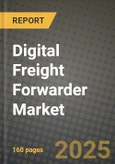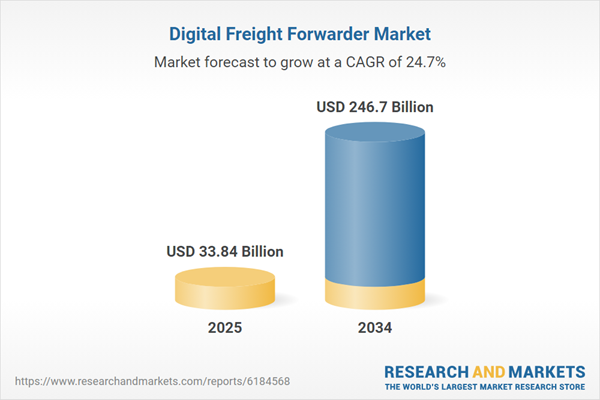Digital Freight Forwarder Market
The digital freight forwarder market is redefining global logistics by replacing manual, fragmented forwarding operations with technology‑enabled, platform‑centric services that streamline booking, documentation, tracking and quoting across ocean, air, road and rail modes. Leading applications include cross‑border shipment management, e‑commerce fulfilment logistics, full‑truckload (FTL) and less‑than‑truckload (LTL) services with real‑time visibility, and value‑added customs/brokerage support. Key trends feature rapid deployment of cloud platforms, AI‑driven route and rate optimisation, digital documentation (e‑bills of lading) and increased transparency for shippers and carriers alike. Driving factors include the surge in global e‑commerce volumes, expansion of international trade lanes, demand for end‑to‑end shipment visibility and cost‑efficient logistics solutions, and emerging supply‑chain digitisation mandates. The competitive landscape is characterised by traditional forwarders acquiring or partnering with digital‑native platforms, pure‑play digital forwarders scaling global footprints, and the entry of technology firms into the forwarding space. Other dynamics include consolidation of capacity, pressure on freight margins, the need for carrier‑networks and asset access, regulatory compliance burden (customs, trade documentation), and infrastructural variations across regions. Overall, the market is poised for strong ongoing growth as shippers increasingly prioritise speed, transparency, agility and platform‑based forwarding services over legacy forwarding operations.Digital Freight Forwarder Market Key Insights
- E commerce acceleration driving demand - Rapid growth of online retail and direct to consumer shipping is increasing the need for agile forwarding platforms that provide end to end visibility and quick booking workflows.
- Platform and automation shift - Digital freight forwarders are increasingly using AI/ML for rate prediction, route optimisation, automated quoting and document processing to reduce manual labour and errors.
- Cloud & real time visibility becoming baseline expectation - Customers expect dashboards, tracking, alerts and analytics as part of the service offering, forcing firms to invest in cloud and integration capabilities.
- Competitive consolidation & partnerships - Traditional large forwarders are acquiring or allying with digital platforms to protect market share, while digital entrants seek scale, carrier networks and global presence.
- Cross border and multimodal complexity adding value - Digitally enabled forwarding firms that can manage customs, multi leg shipments and combined modes (sea + air + road) are differentiating and commanding premium services.
- Regulatory/compliance burdens increasing - Customs clearance, trade documentation, sanctions screening and environmental reporting add layers of complexity that digital forwarders must embed into their platforms to scale.
- Emerging market opportunity and infrastructure gaps - While developed markets lead adoption, emerging markets present high growth potential albeit with challenges around infrastructure, logistics cost and digital readiness.
- Carrier capacity & network access remain a constraint - Forwarders must secure and manage carrier relationships, capacity commitments and pricing volatility to deliver consistent service levels in the platform model.
- Margin pressure cost trade off intensifying - As digital forwarding scales, competition intensifies, tariff compression increases, and firms must balance technology investment with shrinking freight margins.
- Value added services expand monetisation - Beyond basic forwarding, firms are layering services such as customs brokerage, warehousing, return logistics, analytics & optimisation - creating new revenue streams and differentiation.
Digital Freight Forwarder Market Reginal Analysis
North America
The U.S. and Canada dominate early digital forwarding adoption thanks to advanced logistics infrastructure, high e‑commerce penetration and numerous digital freight startups. Many shippers here are shifting to platform‑based forwarding for better visibility and cost control, and large forwarders are aggressively investing in digitisation.Europe
Europe features strong cross‑border trade, regulatory complexity and high service expectations, which fuel demand for digital freight forwarders that can handle customs, compliance and multi‑modal shipments across multiple countries. Adoption is moderate to strong but rental margins and capacity constraints are tighter than in some other regions.Asia‑Pacific
APAC is a high‑growth region for digital forwarding, driven by booming e‑commerce in China, India and Southeast Asia, rising global trade, and increasing digital logistics investment. However, infrastructure, carrier fragmentation and regulatory diversity across countries pose challenges to scaling.Middle East & Africa
Adoption in MEA is emerging; large logistics hubs and trade routes (e.g., Gulf region) offer opportunities but the market remains fragmented, infrastructure investment uneven, and regulatory/legal frameworks in logistics digitisation still maturing.South & Central America
Latin America presents incremental growth opportunities for digital forwarding, particularly in large economies such as Brazil and Mexico, driven by trade liberalisation and e‑commerce growth. But high logistics costs, customs inefficiencies and technology adoption lag somewhat relative to developed markets.Digital Freight Forwarder Market Segmentation
By Function
- Warehouse Management
- Transportation Management
By Mode of Transport
- Land
- Sea
- Air
By Industry
- Retail and e-commerce
- Manufacturing
- Healthcare
- Automotive
- Others
By Deployment Mode
- Cloud
- On-Premises
Key Market players
Flexport, Forto, sennder, Zencargo, Shipa Freight, Kuehne Nagel, eShipAsia, Shiprocket, Beacon, FlexeportDigital Freight Forwarder Market Analytics
The report employs rigorous tools, including Porter’s Five Forces, value chain mapping, and scenario-based modelling, to assess supply-demand dynamics. Cross-sector influences from parent, derived, and substitute markets are evaluated to identify risks and opportunities. Trade and pricing analytics provide an up-to-date view of international flows, including leading exporters, importers, and regional price trends.Macroeconomic indicators, policy frameworks such as carbon pricing and energy security strategies, and evolving consumer behaviour are considered in forecasting scenarios. Recent deal flows, partnerships, and technology innovations are incorporated to assess their impact on future market performance.
Digital Freight Forwarder Market Competitive Intelligence
The competitive landscape is mapped through proprietary frameworks, profiling leading companies with details on business models, product portfolios, financial performance, and strategic initiatives. Key developments such as mergers & acquisitions, technology collaborations, investment inflows, and regional expansions are analyzed for their competitive impact. The report also identifies emerging players and innovative startups contributing to market disruption.Regional insights highlight the most promising investment destinations, regulatory landscapes, and evolving partnerships across energy and industrial corridors.
Countries Covered
- North America - Digital Freight Forwarder market data and outlook to 2034
- United States
- Canada
- Mexico
- Europe - Digital Freight Forwarder market data and outlook to 2034
- Germany
- United Kingdom
- France
- Italy
- Spain
- BeNeLux
- Russia
- Sweden
- Asia-Pacific - Digital Freight Forwarder market data and outlook to 2034
- China
- Japan
- India
- South Korea
- Australia
- Indonesia
- Malaysia
- Vietnam
- Middle East and Africa - Digital Freight Forwarder market data and outlook to 2034
- Saudi Arabia
- South Africa
- Iran
- UAE
- Egypt
- South and Central America - Digital Freight Forwarder market data and outlook to 2034
- Brazil
- Argentina
- Chile
- Peru
Research Methodology
This study combines primary inputs from industry experts across the Digital Freight Forwarder value chain with secondary data from associations, government publications, trade databases, and company disclosures. Proprietary modeling techniques, including data triangulation, statistical correlation, and scenario planning, are applied to deliver reliable market sizing and forecasting.Key Questions Addressed
- What is the current and forecast market size of the Digital Freight Forwarder industry at global, regional, and country levels?
- Which types, applications, and technologies present the highest growth potential?
- How are supply chains adapting to geopolitical and economic shocks?
- What role do policy frameworks, trade flows, and sustainability targets play in shaping demand?
- Who are the leading players, and how are their strategies evolving in the face of global uncertainty?
- Which regional “hotspots” and customer segments will outpace the market, and what go-to-market and partnership models best support entry and expansion?
- Where are the most investable opportunities - across technology roadmaps, sustainability-linked innovation, and M&A - and what is the best segment to invest over the next 3-5 years?
Your Key Takeaways from the Digital Freight Forwarder Market Report
- Global Digital Freight Forwarder market size and growth projections (CAGR), 2024-2034
- Impact of Russia-Ukraine, Israel-Palestine, and Hamas conflicts on Digital Freight Forwarder trade, costs, and supply chains
- Digital Freight Forwarder market size, share, and outlook across 5 regions and 27 countries, 2023-2034
- Digital Freight Forwarder market size, CAGR, and market share of key products, applications, and end-user verticals, 2023-2034
- Short- and long-term Digital Freight Forwarder market trends, drivers, restraints, and opportunities
- Porter’s Five Forces analysis, technological developments, and Digital Freight Forwarder supply chain analysis
- Digital Freight Forwarder trade analysis, Digital Freight Forwarder market price analysis, and Digital Freight Forwarder supply/demand dynamics
- Profiles of 5 leading companies - overview, key strategies, financials, and products
- Latest Digital Freight Forwarder market news and developments
Additional Support
With the purchase of this report, you will receive:- An updated PDF report and an MS Excel data workbook containing all market tables and figures for easy analysis.
- 7-day post-sale analyst support for clarifications and in-scope supplementary data, ensuring the deliverable aligns precisely with your requirements.
- Complimentary report update to incorporate the latest available data and the impact of recent market developments.
This product will be delivered within 1-3 business days.
Table of Contents
Companies Mentioned
- Flexport
- Forto
- sennder
- Zencargo
- Shipa Freight
- Kuehne Nagel
- eShipAsia
- Shiprocket
- Beacon
- Flexeport
Table Information
| Report Attribute | Details |
|---|---|
| No. of Pages | 160 |
| Published | November 2025 |
| Forecast Period | 2025 - 2034 |
| Estimated Market Value ( USD | $ 33.84 Billion |
| Forecasted Market Value ( USD | $ 246.7 Billion |
| Compound Annual Growth Rate | 24.7% |
| Regions Covered | Global |
| No. of Companies Mentioned | 10 |









